
Urban development in Detroit
Encyclopedia
Urban development in Detroit refers to a series of revitalizations, over many decades, aimed at enhancing the city's economy and quality of life. An early effort, in response to civil disturbance and racial unrest in the late 1960s, was the "New Detroit" committee, a group of business and community leaders assigned to explore solutions to urban problems. In 1970, the private group "Detroit Renaissance" began to facilitate development in the city, while its successor, "Business Leaders for Michigan," has continued to facilitate development into the 21st century. Projects have included new commercial facilities, revitalization of neighborhoods, hospitality infrastructure, and improvements to recreational and public facilities.
 Michigan Governor George Romney
Michigan Governor George Romney
, Detroit Mayor Jerome Cavanagh
, and Joseph L. Hudson, Jr. formed the "New Detroit" committee, which included community leaders from business and labor such as Walter Reuther
tasked with identifying solutions to urban problems. Racial tensions which intensified and led to nationwide conflicts in the 1960s provoked the Twelfth Street riot on July 23, 1967. In response, business leaders founded Detroit Renaissance in 1970 to facilitate solutions and urban development. The private group is presently known as Business Leaders for Michigan.
In 1970, Henry Ford II
conceived of the Renaissance Center
as way to help the city retain residents who were moving to the suburbs. The group announced the first phase of construction in 1971. In the 1970s, Detroit Mayor
Roman Gribbs
touted the project as "a complete rebuilding from bridge to bridge," referring to the area between the Ambassador Bridge
that connected Detroit to Windsor, Ontario
and the MacArthur Bridge, which connects the city with Belle Isle
Park. The first tower opened on July 1, 1976. Architects initial design for the Renaissance Center focused on creating secure interior spaces, while its design later expanded to connect with the exterior spaces and waterfront through a reconfigured interior, open glass entryways, and a Wintergarden.
Former Mayor Roman Gribbs
' call for a complete rebuilding from "bridge to bridge" would however come to fruition much later. A study, commissioned by Mayor Kwame Kilpatrick
, recommended the formation of the Detroit Riverfront Conservancy, incorporated as a 501(c)(3) organization. It has raised hundreds of millions of dollars to develop and manage Detroit's riverfront. The International Riverfront area ranges from the Ambassador Bridge
to Belle Isle
in downtown Detroit, Michigan
encompassing a multitude of parks, restaurants, retail shops, skyscrapers, and high rise residential areas along the Detroit River
.
 The city's former mayor in the 1990s, Mayor Dennis Archer
The city's former mayor in the 1990s, Mayor Dennis Archer
, a former Michigan Supreme Court
Justice, supported a plan to add casinos as a catalyst for the development of Detroit. Initially, Archer's plan was for a casino cluster along the east riverfront. After a prolonged court case over the bidding process, the City of Detroit made headway with new casino resorts open for 2008. The plan would change as the city decided instead to have the a promenade of parks along the International Riverfront to spur residential development, thus freeing the casinos to anchor developments in other areas of downtown.
In 2009, "Detroit Renaissance" expanded its mission to address this need for regional economic development; the successor organization, "Business Leaders for Michigan," is "composed exclusively of the chairpersons, chief executives or most senior executives of the state’s largest job providers and universities" and devoted to the creation of a "Michigan turnaround plan" to rebuild the state's economy and restore it to the status of a job-provider. Participants in revitalization efforts include the Detroit Riverfront Conservancy
, the Detroit Economic Club
, and social groups such as the Detroit Club
. Another non-profit organization dedicated to revitalization is Cityscape Detroit. Universities in the Detroit region conduct research in architecture and urban planning. The Michigan Economic Development Corporation has offices in the Cadillac Place
state office complex in the city's New Center
area. In recognition of the city's architecture
and historic significance, the National Register of Historic Places lists many of the city's buildings and districts as historic sites which makes available federal historic tax credits for development. State tax historic tax credits are also available.
To attract residential and commercial development, planners devised a strategy of investing in the riverfront
, the downtown, natural landscapes, and the east side to enhance the city's image and stimulate its economy. The plan included the addition of three casino resorts. As a result, the city is experiencing a significant increase in development. Historic structures are being refurbished into residential high rises and hotels.
, Lafayette Park, East Ferry Avenue Historic District
, Campus Martius
, Grand Circus Park Historic District, and Washington Boulevard Historic District
. In 2002, a major renovation of the historic Cadillac Place
consolidated state offices from around the area into the city's New Center area. In 2003, General Motors completed a $500 million redevelopment of the Renaissance Center as its world headquarters. The east riverfront promenade development for the Detroit International Riverfront
was planned at $559 million, including $135 million from GM and $50 million from the Kresge Foundation. The city has completed major redevelopment of Campus Martius Park
and Cadillac Square Park. The plans have produced new downtown stadiums and a rebuilt freeway system intended to showcase the city for Super Bowl XL
. With $1.6 billion in construction projects in 2004, the rapid pace of development in the city prompted construction of a $30 million cement terminal. In 2007, Bank of America announced that it would commit $25 billion to community development in Michigan following its acquisition of LaSalle Bank in Troy
.
For 2010, the domestic automakers have reported significant profits indicating the beginning of rebound.
Between 2009-2010, Detroit ranked seventh in the nation for economic recovery. A study conducted in 2006 by the University of Michigan-Dearborn
determined that, in addition to the roughly 18,000 employees at the Detroit Metropolitan Wayne County Airport
, activity generated an additional 14,500 jobs in Wayne County and another 70,000 statewide, primarily through firms such as hotels, restaurants, and rental car agencies. The study made the assumption that passenger traffic through the airport and economic activity in these service industries would increase on a 1:1 ratio.
The Wayne County Airport Authority
saw the potential for growth in the air transportation sector almost a decade ago and began a capital improvement plan for the airport. The three original terminals from the 1950s were replaced by two new state-of-the-art terminals that opened in 2002 and 2008, respectively. Other major infrastructure improvements have been made to the runways, cargo facilities, and the terminals themselves with an eye toward increasing the airport’s capacity. At the time, the FAA forecasted a 15.2% growth in passenger travel from 2005 to 2010, and another 12.8% increase from 2010 to 2015. It was projected that the construction projects themselves would create 4,470 jobs, with an additional 21,500 jobs statewide due to increased passenger traffic.
One major focus of the capital improvement plan was to enhance Detroit's international gateway. Total travel has grown due to a surge in international travel, and international flights continued to increase before the recession negatively affected such flights at many airports.
Some other economic development initiatives in Detroit include the following:
Some experts believe that Detroit needs to utilize the region's rich automotive history to break into new industries, such as battery technology, hybrid vehicles, and the auto parts industry, along with auto assembly.
Other experts believe that Detroit's geographic location next to Canada provides a unique opportunity for trade and organizational growth. For example, Detroit's Wayne State University and the University of Windsor, Canada host an annual business symposium in order to tap into this strategic advantage and expand cross-border partnerships between Detroit and the Windsor region.
Quality of life initiatives, including the revitalization of parks, residential units, new construction, and historic renovations are at the forefront of the city's plan to accelerate redevelopment across the city. For instance, in 2004, the city added hundreds of new residential units to its downtown area. From 2000 to 2007, the city saw continuous annual increases in tax revenues from its casinos with the city estimated to collect $178,250,000 in casino taxes alone for 2007, with the casino resorts opening in 2008.

 In April 2008, the city unveiled a $300-million stimulus plan to create jobs and revitalize neighborhoods, financed by city bonds and paid for by earmarking about 15% of the wagering tax. The city's plans for revitalization with the Next Detroit Neighborhood Initiative, a 501 (c)(3) organization, include 7-Mile/Livernois, Brightmoor, East English Village, Grand River/Greenfield, North-End, and Osborn. Private organizations have pledged substantial funding to neighborhood revitalization efforts.
In April 2008, the city unveiled a $300-million stimulus plan to create jobs and revitalize neighborhoods, financed by city bonds and paid for by earmarking about 15% of the wagering tax. The city's plans for revitalization with the Next Detroit Neighborhood Initiative, a 501 (c)(3) organization, include 7-Mile/Livernois, Brightmoor, East English Village, Grand River/Greenfield, North-End, and Osborn. Private organizations have pledged substantial funding to neighborhood revitalization efforts.
A new master plan draft prepared in 2004 has the city composed of ten clusters of neighborhood areas
and commercial districts. The plan revealed that Detroit has many growing neighborhoods with youth population increases of greater than ten percent within each cluster, while also showing that larger youth population losses were focused in certain areas, providing support for the concept of focused redevelopment and planning. The city issued a Strategic Master Plan in 2006. In addition to increased business investment, the city's revitalization has been focused on retaining young professionals. The city has cleared a 1200 acres (485.6 ha) section of land to initiate the Far Eastside Plan for new neighborhood construction and revitalizations. A 2009 parcel survey found 86 percent of the city's homes to be in good condition, with another 9% needing only minor repairs. The survey found 33,527 or 10% of the city's housing to be unoccupied, but recommended that only one percent or 3,480 of the city's housing units needed to be demolished. About 3,000 of these residential structures were cleared away in 2010.
Immigrants have successfully contributed to the city's neighborhood revitalization, especially in southwest Detroit. Southwest Detroit has experienced a thriving economy in recent years, as evidenced by new housing, increased business openings and the recently opened Mexicantown International Welcome Center.
Lafayette Park is a revitalized neighorhood on the city's east side, part of the Mies van der Rohe Residential District listed in the National Register of Historic Places
. The 78 acres (31.6 ha) urban renewal
project was originally called the Gratiot Park Development. Planned by Mies van der Rohe, Ludwig Hilberseimer
and Alfred Caldwell
it includes a landscaped, 19 acres (7.7 ha) park with no through traffic, in which these and other low-rise apartment buildings are situated. Churches, schools, parks, theaters
, and retail have helped to anchor neighborhoods in the city.
 Old buildings in the city are being transformed into lofts, condominiums, and luxury high rise residential units at an accelerated pace along with new Formstone and brick rowhouses
Old buildings in the city are being transformed into lofts, condominiums, and luxury high rise residential units at an accelerated pace along with new Formstone and brick rowhouses
construction.
Many more projects are in the process of planning/rendering and this is all helping bring back more residents to the downtown area.
, and Four Seasons
. Some buildings are being redeveloped into high-rise condominiums and residential lofts. These projects are attracting new investment in corporate headquarters, offices, and retail. Some significant renovations include:
History

George W. Romney
George Wilcken Romney was an American businessman and Republican Party politician. He was chairman and CEO of American Motors Corporation from 1954 to 1962, the 43rd Governor of Michigan from 1963 to 1969, and the United States Secretary of Housing and Urban Development from 1969 to 1973...
, Detroit Mayor Jerome Cavanagh
Jerome Cavanagh
Jerome Patrick Cavanagh was the mayor of Detroit, Michigan from 1962 to 1970. Initially seen as another John F. Kennedy, his reputation was doomed by the 1967 riots. He was the first mayor to inhabit the Manoogian Mansion, donated to the city by the industrial baron Alex Manoogian.-Early...
, and Joseph L. Hudson, Jr. formed the "New Detroit" committee, which included community leaders from business and labor such as Walter Reuther
Walter Reuther
Walter Philip Reuther was an American labor union leader, who made the United Automobile Workers a major force not only in the auto industry but also in the Democratic Party in the mid 20th century...
tasked with identifying solutions to urban problems. Racial tensions which intensified and led to nationwide conflicts in the 1960s provoked the Twelfth Street riot on July 23, 1967. In response, business leaders founded Detroit Renaissance in 1970 to facilitate solutions and urban development. The private group is presently known as Business Leaders for Michigan.
In 1970, Henry Ford II
Henry Ford II
Henry Ford II , commonly known as "HF2" and "Hank the Deuce", was the son of Edsel Ford and grandson of Henry Ford...
conceived of the Renaissance Center
Renaissance Center
Renaissance Center is a group of seven interconnected skyscrapers in Downtown Detroit, Michigan, United States. Located on the International Riverfront, the Renaissance Center complex is owned by General Motors as its world headquarters...
as way to help the city retain residents who were moving to the suburbs. The group announced the first phase of construction in 1971. In the 1970s, Detroit Mayor
Mayor
In many countries, a Mayor is the highest ranking officer in the municipal government of a town or a large urban city....
Roman Gribbs
Roman Gribbs
Roman Stanley Gribbs was the Mayor of Detroit from 1970 to 1974. Later, Gribbs served as a judge on the Michigan Court of Appeals.-Biography:...
touted the project as "a complete rebuilding from bridge to bridge," referring to the area between the Ambassador Bridge
Ambassador Bridge
The Ambassador Bridge is a suspension bridge that connects Detroit, Michigan, in the United States, with Windsor, Ontario, in Canada. It is the busiest international border crossing in North America in terms of trade volume: more than 25 percent of all merchandise trade between the United States...
that connected Detroit to Windsor, Ontario
Windsor, Ontario
Windsor is the southernmost city in Canada and is located in Southwestern Ontario at the western end of the heavily populated Quebec City – Windsor Corridor. It is within Essex County, Ontario, although administratively separated from the county government. Separated by the Detroit River, Windsor...
and the MacArthur Bridge, which connects the city with Belle Isle
Belle Isle
- Places :In Canada* Belle Isle , an island and strait In England, UK* Belle Isle, an area of Leeds, West Yorkshire* Belle Isle , an island in Lake District, Cumbria...
Park. The first tower opened on July 1, 1976. Architects initial design for the Renaissance Center focused on creating secure interior spaces, while its design later expanded to connect with the exterior spaces and waterfront through a reconfigured interior, open glass entryways, and a Wintergarden.
Former Mayor Roman Gribbs
Roman Gribbs
Roman Stanley Gribbs was the Mayor of Detroit from 1970 to 1974. Later, Gribbs served as a judge on the Michigan Court of Appeals.-Biography:...
' call for a complete rebuilding from "bridge to bridge" would however come to fruition much later. A study, commissioned by Mayor Kwame Kilpatrick
Kwame Kilpatrick
Kwame Malik Kilpatrick is a former mayor of Detroit, Michigan. Kilpatrick's mayorship was plagued by numerous scandals and rampant accusations of corruption, with the mayor eventually resigning after being charged with ten felony counts, including perjury and obstruction of justice...
, recommended the formation of the Detroit Riverfront Conservancy, incorporated as a 501(c)(3) organization. It has raised hundreds of millions of dollars to develop and manage Detroit's riverfront. The International Riverfront area ranges from the Ambassador Bridge
Ambassador Bridge
The Ambassador Bridge is a suspension bridge that connects Detroit, Michigan, in the United States, with Windsor, Ontario, in Canada. It is the busiest international border crossing in North America in terms of trade volume: more than 25 percent of all merchandise trade between the United States...
to Belle Isle
Belle Isle Park
Belle Isle is a island park in the Detroit River, between the United States mainland and Canada, managed by the Detroit Recreation Department. It is connected to the rest of Detroit, Michigan by the MacArthur Bridge...
in downtown Detroit, Michigan
Michigan
Michigan is a U.S. state located in the Great Lakes Region of the United States of America. The name Michigan is the French form of the Ojibwa word mishigamaa, meaning "large water" or "large lake"....
encompassing a multitude of parks, restaurants, retail shops, skyscrapers, and high rise residential areas along the Detroit River
Detroit River
The Detroit River is a strait in the Great Lakes system. The name comes from the French Rivière du Détroit, which translates literally as "River of the Strait". The Detroit River has served an important role in the history of Detroit and is one of the busiest waterways in the world. The river...
.

Dennis Archer
Dennis Wayne Archer is an American lawyer and politician from Michigan. A Democrat, Archer served on the Michigan Supreme Court and as mayor of Detroit...
, a former Michigan Supreme Court
Michigan Supreme Court
The Michigan Supreme Court is the highest court in the U.S. state of Michigan. It is known as Michigan's "court of last resort" and consists of seven justices who are elected to eight-year terms. Candidates are nominated by political parties and are elected on a nonpartisan ballot...
Justice, supported a plan to add casinos as a catalyst for the development of Detroit. Initially, Archer's plan was for a casino cluster along the east riverfront. After a prolonged court case over the bidding process, the City of Detroit made headway with new casino resorts open for 2008. The plan would change as the city decided instead to have the a promenade of parks along the International Riverfront to spur residential development, thus freeing the casinos to anchor developments in other areas of downtown.
In 2009, "Detroit Renaissance" expanded its mission to address this need for regional economic development; the successor organization, "Business Leaders for Michigan," is "composed exclusively of the chairpersons, chief executives or most senior executives of the state’s largest job providers and universities" and devoted to the creation of a "Michigan turnaround plan" to rebuild the state's economy and restore it to the status of a job-provider. Participants in revitalization efforts include the Detroit Riverfront Conservancy
Detroit International Riverfront
The Detroit International Riverfront is an area of Detroit, Michigan that borders the Detroit River. The International Riverfront area extends from the Ambassador Bridge in the west to Belle Isle in the east, extending a total of 5½-miles and encompassing a multitude of parks, restaurants, retail...
, the Detroit Economic Club
Detroit Economic Club
The Detroit Economic Club, headquartered at 211 West Fort Street in downtown Detroit, Michigan, was formed in 1934 as a platform for the discussion and debate of important business, government and social issues...
, and social groups such as the Detroit Club
Detroit Club
The Detroit Club is a private social club located at 712 Cass Avenue in Downtown Detroit, Michigan. The building was constructed in 1891 and listed on the National Register of Historic Places in 2005.- History :...
. Another non-profit organization dedicated to revitalization is Cityscape Detroit. Universities in the Detroit region conduct research in architecture and urban planning. The Michigan Economic Development Corporation has offices in the Cadillac Place
Cadillac Place
Cadillac Place is an ornate high-rise class-A office complex in the New Center area of Detroit, Michigan constructed of steel, limestone, granite, and marble between 1919 and 1923 and was listed as a National Historic Landmark in 1985. The building houses several agencies of the State of Michigan...
state office complex in the city's New Center
New Center, Detroit
The New Center is a significant commercial and residential historic district located in Detroit, Michigan, adjacent to Midtown, one mile north of the Cultural Center, and approximately three miles north of Downtown...
area. In recognition of the city's architecture
Architecture of metropolitan Detroit
The architecture of metropolitan Detroit, Michigan continues to attract the attention of architects and preservationists alike. With one of the world's recognizable skylines, Detroit's waterfront panorama shows a variety of architectural styles. The city's historic Art Deco skyscrapers blend with...
and historic significance, the National Register of Historic Places lists many of the city's buildings and districts as historic sites which makes available federal historic tax credits for development. State tax historic tax credits are also available.
To attract residential and commercial development, planners devised a strategy of investing in the riverfront
Detroit International Riverfront
The Detroit International Riverfront is an area of Detroit, Michigan that borders the Detroit River. The International Riverfront area extends from the Ambassador Bridge in the west to Belle Isle in the east, extending a total of 5½-miles and encompassing a multitude of parks, restaurants, retail...
, the downtown, natural landscapes, and the east side to enhance the city's image and stimulate its economy. The plan included the addition of three casino resorts. As a result, the city is experiencing a significant increase in development. Historic structures are being refurbished into residential high rises and hotels.
Initiatives
Some of Detroit's successful revitalizations include the New CenterNew Center, Detroit
The New Center is a significant commercial and residential historic district located in Detroit, Michigan, adjacent to Midtown, one mile north of the Cultural Center, and approximately three miles north of Downtown...
, Lafayette Park, East Ferry Avenue Historic District
East Ferry Avenue Historic District
The East Ferry Avenue Historic District is a historic residential district in Detroit, Michigan. The nationally-designated historic district stretches two blocks from Woodward Avenue east to Brush; the locally-designated historic district includes a third block between Brush and Beaubien. The...
, Campus Martius
Campus Martius Park
Campus Martius Park is a re-established park in downtown Detroit, Michigan. After the fire of 1805, Campus Martius was the focal point of judge Augustus Woodward's plans to rebuild the city. It is where the "point of origin" of Detroit's coordinate system is located...
, Grand Circus Park Historic District, and Washington Boulevard Historic District
Washington Boulevard Historic District
Washington Boulevard Historic District is a multi-block area of downtown Detroit, Michigan. It is bounded by Washington Boulevard between State and Clifford streets. In 1982, it was added to the National Register of Historic Places...
. In 2002, a major renovation of the historic Cadillac Place
Cadillac Place
Cadillac Place is an ornate high-rise class-A office complex in the New Center area of Detroit, Michigan constructed of steel, limestone, granite, and marble between 1919 and 1923 and was listed as a National Historic Landmark in 1985. The building houses several agencies of the State of Michigan...
consolidated state offices from around the area into the city's New Center area. In 2003, General Motors completed a $500 million redevelopment of the Renaissance Center as its world headquarters. The east riverfront promenade development for the Detroit International Riverfront
Detroit International Riverfront
The Detroit International Riverfront is an area of Detroit, Michigan that borders the Detroit River. The International Riverfront area extends from the Ambassador Bridge in the west to Belle Isle in the east, extending a total of 5½-miles and encompassing a multitude of parks, restaurants, retail...
was planned at $559 million, including $135 million from GM and $50 million from the Kresge Foundation. The city has completed major redevelopment of Campus Martius Park
Campus Martius Park
Campus Martius Park is a re-established park in downtown Detroit, Michigan. After the fire of 1805, Campus Martius was the focal point of judge Augustus Woodward's plans to rebuild the city. It is where the "point of origin" of Detroit's coordinate system is located...
and Cadillac Square Park. The plans have produced new downtown stadiums and a rebuilt freeway system intended to showcase the city for Super Bowl XL
Super Bowl XL
Super Bowl XL was an American football game pitting the American Football Conference champion Pittsburgh Steelers against the National Football Conference champion Seattle Seahawks to decide the National Football League champion for the 2005 season...
. With $1.6 billion in construction projects in 2004, the rapid pace of development in the city prompted construction of a $30 million cement terminal. In 2007, Bank of America announced that it would commit $25 billion to community development in Michigan following its acquisition of LaSalle Bank in Troy
Troy, Michigan
Troy is a city in Oakland County in the U.S. state of Michigan, and is a suburb of Detroit. The population was 80,980 at the 2010 census, making it the 11th-largest city in Michigan by population, and the largest city in Oakland County...
.
For 2010, the domestic automakers have reported significant profits indicating the beginning of rebound.
Between 2009-2010, Detroit ranked seventh in the nation for economic recovery. A study conducted in 2006 by the University of Michigan-Dearborn
University of Michigan-Dearborn
The University of Michigan–Dearborn , is a public university located in Dearborn, Michigan, USA.The University of Michigan–Dearborn is one of two regional campuses of the University of Michigan...
determined that, in addition to the roughly 18,000 employees at the Detroit Metropolitan Wayne County Airport
Detroit Metropolitan Wayne County Airport
Detroit Metropolitan Wayne County Airport , usually called Detroit Metro Airport, Metro Airport locally, or simply DTW, is a major international airport covering in Romulus, Michigan, a suburb of Detroit. It is Michigan's busiest airport....
, activity generated an additional 14,500 jobs in Wayne County and another 70,000 statewide, primarily through firms such as hotels, restaurants, and rental car agencies. The study made the assumption that passenger traffic through the airport and economic activity in these service industries would increase on a 1:1 ratio.
The Wayne County Airport Authority
Wayne County Airport Authority
Wayne County Airport Authority is a governmental entity that operates airports in Metro Detroit in Michigan. The agency has its headquarters in the L.C. Smith Terminal at Detroit Metropolitan Wayne County Airport in Romulus...
saw the potential for growth in the air transportation sector almost a decade ago and began a capital improvement plan for the airport. The three original terminals from the 1950s were replaced by two new state-of-the-art terminals that opened in 2002 and 2008, respectively. Other major infrastructure improvements have been made to the runways, cargo facilities, and the terminals themselves with an eye toward increasing the airport’s capacity. At the time, the FAA forecasted a 15.2% growth in passenger travel from 2005 to 2010, and another 12.8% increase from 2010 to 2015. It was projected that the construction projects themselves would create 4,470 jobs, with an additional 21,500 jobs statewide due to increased passenger traffic.
One major focus of the capital improvement plan was to enhance Detroit's international gateway. Total travel has grown due to a surge in international travel, and international flights continued to increase before the recession negatively affected such flights at many airports.
Some other economic development initiatives in Detroit include the following:
- The Detroit Office of Targeted Business Development is also working to “utilize the City’s enormous buying power to re-circulate Detroit dollars within the local economy as many times as possible and to work collaboratively with other City agencies such as the Mayor’s Office of Neighborhood Commercial Revitalization (ONCR), with the ultimate goal of building and sustaining both the commercial infrastructure and the residential neighborhoods, thus transforming the Next Detroit." This includes facilitating the startup and growth of Detroit-based, women-owned businesses; Detroit-based minority-owned businesses; and Detroit-based small businesses.
- The Michigan Small Business Technology Development Center works to strengthen companies, create new jobs, retain existing jobs, and assist companies in defining their path to success.
- The Detroit Economic Growth Corporation (DEGC) manages major economic development initiatives on behalf of the City of Detroit, including transforming the East Riverfront District, developing the I-94 Industrial Park, managing the Lower Woodward Improvement Program, and creating the Paradise Valley Cultural and Entertainment District. The DEGC also provides staff services to Detroit’s public development authorities.
- The City of Detroit Downtown Development Authority supports private investments and business growth within Detroit’s central business district with loans, sponsorships and grants, capital improvements to public infrastructure, and other programs that increase economic activity.
- The Detroit Brownfield Redevelopment Authority (DBRA) to promote revitalization of environmental clean-up areas within the boundaries of the City of Detroit. The DBRA has approved over 160 brownfield plans, which are expected create $6 billion in new investments, 13,000 jobs, and over 9,000 housing units.
- The Economic Development Corporation of the City of Detroit assists local industrial and commercial enterprises to strengthen and revitalize the city and state economy through a loan program, public infrastructure improvements, and other programs.
- The Office of Neighborhood Commercial Revitalization (ONCR) has created a system of support services and strategies to targeted commercial strips, incorporating technical assistance and training, grants, and loans to address local business development. Some programs from the ONCR include Re$tore Detroit, ReFresh Detroit, and Small Business Detroit! Microloan, all of which provide financial support and assistance.
- The Michigan Works! System is the first unified workforce development system in the country and an instrumental partner for developing Michigan’s economic future. The system comprises twenty-five agencies that focus on innovative, proactive solutions to meet the demands of a rapidly changing economy.
- John Hantz, a successful financial consultant in Detroit, is devoting $30 million of his own funding to create Hantz Farms, a commercial urban agricultureUrban agricultureUrban agriculture is the practice of cultivating, processing and distributing food in, or around, a village, town or city. Urban agriculture in addition can also involve animal husbandry, aquaculture, agro-forestry and horticulture...
initiative. The company will be owned, operated and staffed by local residents and make use of a portion of the city's tax-delinquent land parcels.
Some experts believe that Detroit needs to utilize the region's rich automotive history to break into new industries, such as battery technology, hybrid vehicles, and the auto parts industry, along with auto assembly.
Other experts believe that Detroit's geographic location next to Canada provides a unique opportunity for trade and organizational growth. For example, Detroit's Wayne State University and the University of Windsor, Canada host an annual business symposium in order to tap into this strategic advantage and expand cross-border partnerships between Detroit and the Windsor region.
Quality of life initiatives, including the revitalization of parks, residential units, new construction, and historic renovations are at the forefront of the city's plan to accelerate redevelopment across the city. For instance, in 2004, the city added hundreds of new residential units to its downtown area. From 2000 to 2007, the city saw continuous annual increases in tax revenues from its casinos with the city estimated to collect $178,250,000 in casino taxes alone for 2007, with the casino resorts opening in 2008.
Neighborhood revitalization


A new master plan draft prepared in 2004 has the city composed of ten clusters of neighborhood areas
Master Plan Neighborhood areas in Detroit
Master Plan Neighborhood areas in Detroit are statistical divisions created by the City of Detroit Planning & Development Department and used for urban planning purposes by the city and statistical agencies, charities, non-profits, and other local organizations. The city is divided into 55...
and commercial districts. The plan revealed that Detroit has many growing neighborhoods with youth population increases of greater than ten percent within each cluster, while also showing that larger youth population losses were focused in certain areas, providing support for the concept of focused redevelopment and planning. The city issued a Strategic Master Plan in 2006. In addition to increased business investment, the city's revitalization has been focused on retaining young professionals. The city has cleared a 1200 acres (485.6 ha) section of land to initiate the Far Eastside Plan for new neighborhood construction and revitalizations. A 2009 parcel survey found 86 percent of the city's homes to be in good condition, with another 9% needing only minor repairs. The survey found 33,527 or 10% of the city's housing to be unoccupied, but recommended that only one percent or 3,480 of the city's housing units needed to be demolished. About 3,000 of these residential structures were cleared away in 2010.
Immigrants have successfully contributed to the city's neighborhood revitalization, especially in southwest Detroit. Southwest Detroit has experienced a thriving economy in recent years, as evidenced by new housing, increased business openings and the recently opened Mexicantown International Welcome Center.
Lafayette Park is a revitalized neighorhood on the city's east side, part of the Mies van der Rohe Residential District listed in the National Register of Historic Places
National Register of Historic Places
The National Register of Historic Places is the United States government's official list of districts, sites, buildings, structures, and objects deemed worthy of preservation...
. The 78 acres (31.6 ha) urban renewal
Urban renewal
Urban renewal is a program of land redevelopment in areas of moderate to high density urban land use. Renewal has had both successes and failures. Its modern incarnation began in the late 19th century in developed nations and experienced an intense phase in the late 1940s – under the rubric of...
project was originally called the Gratiot Park Development. Planned by Mies van der Rohe, Ludwig Hilberseimer
Ludwig Hilberseimer
Ludwig Karl Hilberseimer was a German architect and urban planner best known for his ties to the Bauhaus and to Mies van der Rohe, as well as for his work in urban planning at Armour Institute of Technology , in Chicago, Illinois.-Life:Hilberseimer studied architecture at the Karlsruhe Technical...
and Alfred Caldwell
Alfred Caldwell
Alfred Caldwell was an American architect best known for his landscape architecture in and around Chicago, Illinois.- Career :* Attended the University of Illinois at Urbana-Champaign, left before completing a degree....
it includes a landscaped, 19 acres (7.7 ha) park with no through traffic, in which these and other low-rise apartment buildings are situated. Churches, schools, parks, theaters
Theatre in Detroit
Theatre in Detroit discusses performing arts in the city, its history, and its venues. With more than a dozen performing arts venues, the city's theatre district ranks as the second largest in the United States after Manhattan's Broadway, the stages and old time film palaces are generally located...
, and retail have helped to anchor neighborhoods in the city.
Partial list of new residential developments

Formstone
Formstone is a type of stucco commonly applied to brick rowhouses in many East Coast urban areas in the United States, although it is most strongly associated with Baltimore...
construction.
- Brownstones on John R., luxury brownstones (2007)
- Carlton luxury condominiums ( 2007)
- 1001 Covington, luxury condominiums (2007)
- The Elmore, converting to luxury condominiums (2007)
- FD Lofts and New Central Yard in the Eastern MarketEastern MarketEastern Market may refer to:in Australia* Eastern Market, Melbournein the United States* Eastern Market Historic District, Detroit, Michigan* Eastern Market, Washington, D.C., a marketplace listed on the NRHP...
area and Regina Condominiums in Brush Park. - The Grisswold-Capitol Park, luxury condominiums (2007), delayed until further notice
- Hilton Fort ShelbyFort Shelby HotelThe DoubleTree Guest Suites Fort Shelby/Detroit Downtown is a restored historic high-rise hotel, located at 525 West Lafayette Boulevard in downtown Detroit, Michigan, United States. It was originally named the "Fort Shelby Hotel" when it opened its doors in 1916. In 1951 it was renamed the "Pick...
, upper hotel rentals (2008). - The Park Shelton, luxury lofts/condominiums (2006)
- Riverfront Towers, luxury condominiums (2005).
- Garden Lofts at Woodward Place, luxury condominiums (2008)
- St. Anne's Gate of Detroit, townhouseTownhouseA townhouse is the term historically used in the United Kingdom, Ireland and in many other countries to describe a residence of a peer or member of the aristocracy in the capital or major city. Most such figures owned one or more country houses in which they lived for much of the year...
s (2007). - English Village, townhouses (2007)
- Edmond Place, refurbished Victorian mansions (2007)
- Ferry Street East Townhouses (2007)
- Garden Court condominiums (2007)
- Green Acres Brownstones, luxury brownstones (2007)
- HarborTown, luxury condominiums (2007)
- Heritage at Riverbend, townhouses (2007)
- Jefferson Village, single family homes (2007)
- 1300 E. Lafayette, condominiums (2007)
- Nine On Third, luxury condominiums (2007)
- Lofts at New Center, townhouses (2007).
- Ren Shores, lLuxury Condominiums (2009)
- Research Lofts on Trumbull Ave., loft condominiums (2007)
- Rock Custom Homes, single family homes (2008)
- ShorePoint Village, luxury detached condominiums (2007)
- Watermark DetroitWatermark DetroitThe Watermark Detroit project is one of three condo developments chosen to fill sites along the Detroit Riverfront once occupied by cement companies...
, luxury condominiums (2009) - Westin Book-CadillacWestin Book-Cadillac HotelThe Westin Book Cadillac Detroit is a restored historic skyscraper hotel In the Washington Boulevard Historic District of downtown Detroit, Michigan. Designed in the Neo-Renaissance style, and constructed as the Book-Cadillac, it is part of Westin Hotels and embodies Neo-Classical elements and...
, upper hotel luxury condominiums (2008) - Wood Bridge Estates, master plan community (2006)
- 1001 Woodward1001 Woodward1001 Woodward is a mixed-use skyscraper in downtown Detroit, Michigan. The building is located just south of the neighboring David Stott Building, at the corner of Woodward Avenue and Michigan Avenue overlooking Campus Martius Park...
, luxury condominiums (2007) - Woodward Place in Brush Park, townhouses (2007)
Many more projects are in the process of planning/rendering and this is all helping bring back more residents to the downtown area.
Renovated structures
Significant renovations are owned by luxury hotel developers downtown such as Hilton, Westin, Double TreeDouble tree
Double Tree may refer to:*Double Tree Hotels*Whippletree...
, and Four Seasons
Four Seasons Hotels and Resorts
Four Seasons Hotels, Inc. is a Canadian-based international ultra-luxury, five-star hotel management company. Travel + Leisure magazine and Zagat Survey rank the hotel chain's 84 properties among the top luxury hotels worldwide...
. Some buildings are being redeveloped into high-rise condominiums and residential lofts. These projects are attracting new investment in corporate headquarters, offices, and retail. Some significant renovations include:
| Name | Built | Architect | Location | Notes | Image |
|---|---|---|---|---|---|
| Argonaut Building Argonaut Building The Argonaut Building, renamed in 2009 the A. Alfred Taubman Center for Design Education , is a large office building located in the New Center area of Detroit, Michigan. The building is located at 485 West Milwaukee Avenue, and is located across the street from Cadillac Place... |
1930 | Albert Kahn | 485 W. Milwaukee Ave. | General Motors donated the building to the College for Creative Studies College for Creative Studies College for Creative Studies is an art education institution in the United States and was cited by BusinessWeek as one of the 60 best design schools in the world. It is a private, fully accredited, four-year college located in Detroit, Michigan... . Renovated in 2009. |
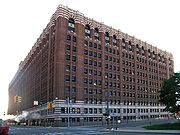 |
| Cadillac Place Cadillac Place Cadillac Place is an ornate high-rise class-A office complex in the New Center area of Detroit, Michigan constructed of steel, limestone, granite, and marble between 1919 and 1923 and was listed as a National Historic Landmark in 1985. The building houses several agencies of the State of Michigan... |
1923 | Albert Kahn | 3044 W. Grand Blvd. | Renovated in 2002 as a state office complex. |  |
| David Broderick Tower David Broderick Tower The Broderick Tower is a skyscraper in Detroit, Michigan currently under redevelopment. Construction began in 1926, and was completed in 1928. The tower was the second tallest building in Michigan when it was completed in 1928. It stands 35-stories tall, with two basement floors. The building is... |
1928 | Paul and Louis Kamper Louis Kamper Louis Kamper was an American architect, active in and aroundDetroit and Wayne County, Michigan, in the United States.-Project range:... |
10 Witherell St. | Redevelopment in 2011 as a residential high-rise. |  |
| Detroit Building Detroit Building The Detroit Building is a high-rise office building located in downtown Detroit, Michigan at 2210 Park Avenue, in the Park Avenue Historic District, in the Foxtown neighbourhood. The building was constructed in 1923, and stands at 10 floors in height. It was designed in the Beaux-Arts... |
1923 | Arnold & Shreve | 2100 Park Ave. | Renovated in 2009. It is part of the Park Avenue Historic District Park Avenue Historic District (Detroit, Michigan) The Park Avenue Historic District is a historic district located in Detroit, Michigan, along Park Avenue between Adams St. and I-75. The district includes the Women's City Club, the Detroit Building, the Park Avenue House, and the Kales Building... . It serves as offices for Illitch enterprises. |
|
| The Detroit Free Press Building Detroit Free Press Building The Detroit Free Press Building is a building designed by architect Albert Kahn and constructed in downtown Detroit, Michigan, in 1924 and completed a year later.... |
1925 | Albert Kahn | 321 West Lafayette Blvd. | Former HQ of Detroit Free Press Detroit Free Press The Detroit Free Press is the largest daily newspaper in Detroit, Michigan, USA. The Sunday edition is entitled the Sunday Free Press. It is sometimes informally referred to as the "Freep"... , mixed-use residential and retail redevelopment in 2011. |
 |
| Fort Shelby Hotel Fort Shelby Hotel The DoubleTree Guest Suites Fort Shelby/Detroit Downtown is a restored historic high-rise hotel, located at 525 West Lafayette Boulevard in downtown Detroit, Michigan, United States. It was originally named the "Fort Shelby Hotel" when it opened its doors in 1916. In 1951 it was renamed the "Pick... |
1916/1927 | Albert Kahn | 525 W. Lafayette Blvd. | Renovated in 2008 as a Double Tree hotel. | |
| Harmonie Centre | 1905 | Raseman & Fischer | 1308 Broadway | Also known as Breitmeyer-Tobin Building. It is part of the Broadway Avenue Historic District Broadway Avenue Historic District (Detroit, Michigan) The Broadway Avenue Historic District is a historic district located on a single city block along Broadway Avenue between Gratiot and East Grand River in Downtown Detroit, Michigan. It was listed on the National Register of Historic Places in 2004... . |
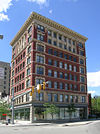 |
| Kales Building Kales Building The Kales Building is a high-rise apartment building in downtown Detroit, Michigan. It is located 76 West Adams at the northeast corner of Adams Avenue West and Park Avenue, across from Grand Circus Park, in the Foxtown neighborhood, just north of Downtown... |
1914 | Albert Kahn | 76 W. Adams St. | Redeveloped in 2004 as a residential high-rise with retail. It is part of the Park Avenue Historic District Park Avenue Historic District (Detroit, Michigan) The Park Avenue Historic District is a historic district located in Detroit, Michigan, along Park Avenue between Adams St. and I-75. The district includes the Women's City Club, the Detroit Building, the Park Avenue House, and the Kales Building... . |
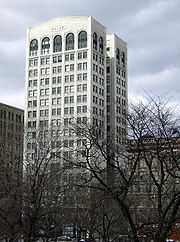 |
| The Leland Hotel The Leland Hotel (Detroit, Michigan) The Detroit-Leland Hotel is a renovated historic hotel located at 400 Bagley Street in Detroit, Michigan, United States. It was listed on the National Register of Historic Places in 2005. The ballroom of the Detroit-Leland has hosted a nightclub, the City Club, since 1983... |
1927 | Rapp and Rapp Rapp and Rapp The architectural firm Rapp and Rapp was active in Chicago, Illinois during the early 20th century. The brothers Cornelius W. Rapp and George Leslie Rapp of Carbondale, Illinois were the named partners and 1899 alumnus of the University of Illinois School of Architecture... |
400 Bagley St. | Redeveloped as a residential high rise, hotel, and night club. | |
| Neighborhood Service Organization Building Michigan Bell and Western Electric Warehouse The Michigan Bell and Western Electric Warehouse is a former commercial warehouse building located at 882 Oakman Boulevard in Detroit, Michigan. It was listed on the National Register of Historic Places in 2009... |
1929 | 882 Oakman Blvd. | Redeveloped as the Neighborhood Service Organization (NSO) Building, it was formerly the Michigan Bell and Western Electric Warehouse. Total investment estimated at $50 M. | ||
| Riverwalk Hotel | 1902 | Donaldson and Meier Donaldson and Meier Donaldson and Meier was an architectural firm based in Detroit, Michigan. Founded in 1880 by John Donaldson and Henry J. Meier the firm produced a large and varied number of commissions in Detroit and southeastern Michigan... , Albert Kahn |
1000 River Place | Former Parke-Davis Parke-Davis Parke-Davis is a subsidiary of the pharmaceutical company Pfizer. Although no longer an independent corporation, it was once America's oldest and largest drug maker, and played an important role in medical history.- History :... research laboratory, redeveloped as a hotel and residence. |
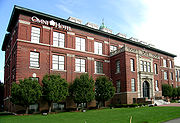 |
| Park Avenue House | 1924 | Louis Kamper Louis Kamper Louis Kamper was an American architect, active in and aroundDetroit and Wayne County, Michigan, in the United States.-Project range:... |
2305 Park Ave. | Also known as the Royal Palm. It is part of the Park Avenue Historic District Park Avenue Historic District (Detroit, Michigan) The Park Avenue Historic District is a historic district located in Detroit, Michigan, along Park Avenue between Adams St. and I-75. The district includes the Women's City Club, the Detroit Building, the Park Avenue House, and the Kales Building... . The Towne Pump Tavern is located on the ground floor. |
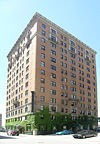 |
| River Place | 1891 | Donaldson and Meier Donaldson and Meier Donaldson and Meier was an architectural firm based in Detroit, Michigan. Founded in 1880 by John Donaldson and Henry J. Meier the firm produced a large and varied number of commissions in Detroit and southeastern Michigan... , Albert Kahn, and Smith, Hinchman and Grylls |
Former Parke-Davis Parke-Davis Parke-Davis is a subsidiary of the pharmaceutical company Pfizer. Although no longer an independent corporation, it was once America's oldest and largest drug maker, and played an important role in medical history.- History :... pharmaceutical plant, redeveloped as a mixed use residential complex of buildings. |
 |
|
| Vinton Building Vinton Building The Vinton Building is a residential high-rise located at 600 Woodward Avenue in Detroit, Michigan. It is located next to the First National Building, and stands across Woodward Avenue from Chase Tower, and across Congress Street from Comerica Tower and the Guardian Building... |
1916 | Albert Kahn | 600 Woodward Ave. | Redeveloped in 2007 as a residential high-rise. | 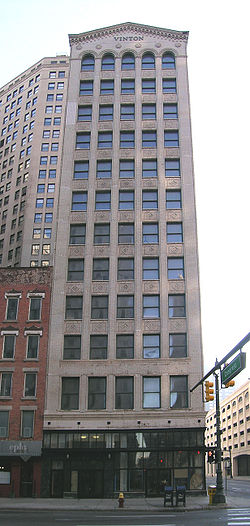 |
| Westin Book-Cadillac Hotel Westin Book-Cadillac Hotel The Westin Book Cadillac Detroit is a restored historic skyscraper hotel In the Washington Boulevard Historic District of downtown Detroit, Michigan. Designed in the Neo-Renaissance style, and constructed as the Book-Cadillac, it is part of Westin Hotels and embodies Neo-Classical elements and... |
1924 | Louis Kamper | 1114 Washington Blvd. | Renovated in 2008 as a Westin hotel. |  |
| The Whittier | 1922 | Charles N. Agree Charles N. Agree Charles Nathanial Agree was an architect who held his practice in Detroit, Michigan.Agree moved to Detroit in 1909 at the age of 12. He began his firm in 1917, after he graduated from the Detroit Y.M.C.A Technical School. His first major commission came in 1921 to build the Whittier Hotel near... |
415 Burns Dr. | Renovated in 2003 as a residential high-rise. |  |
Vacant structures
The city has demolished many unused buildings in order to make way for new development. Significant vacant buildings include:| Name | Built | Architect | Location | Notes | Image |
|---|---|---|---|---|---|
| Belle Isle Aquarium Belle Isle Aquarium The Belle Isle Aquarium, located on Belle Isle Park in Detroit, Michigan, was the oldest continually-operating aquarium in North America. Designed by noted architect Albert Kahn, it opened on August 18, 1904 and closed April 3, 2005 [... |
1904 | Albert Kahn | Conservatory Drive and Inselhrue Ave. | Closed despite immense citizen opposition. Non profit group attempting to reopen the aquarium. |  |
| Book Tower Book Tower Book Tower is a , 38-story skyscraper in the Washington Boulevard Historic District of Detroit, Michigan. Construction began on the Italian Renaissance-style building in 1916 as an addition to the original Book Building and finished a decade later... |
1916/1926 | Louis Kamper Louis Kamper Louis Kamper was an American architect, active in and aroundDetroit and Wayne County, Michigan, in the United States.-Project range:... |
1265 Washington Boulevard Washington Boulevard Historic District Washington Boulevard Historic District is a multi-block area of downtown Detroit, Michigan. It is bounded by Washington Boulevard between State and Clifford streets. In 1982, it was added to the National Register of Historic Places... |
Vacated in late 2008, now slated for a 'green' renovation. |  |
| The Charlevoix Building | 1905 | William S. Joy | 2029 Park Avenue | Beaux-Arts styled brick residential building. | |
| David Whitney Building David Whitney Building The David Whitney Building is a historic class-A skyscraper on the northern edge of downtown Detroit, Michigan. It is located at 1553 Woodward Avenue, adjacent to Grand Circus Park. The building stands on a wedge-shaped site at the junction of Park Avenue, Woodward Avenue, and Washington Boulevard.... |
1914 | Daniel Burnham Daniel Burnham Daniel Hudson Burnham, FAIA was an American architect and urban planner. He was the Director of Works for the World's Columbian Exposition in Chicago. He took a leading role in the creation of master plans for the development of a number of cities, including Chicago and downtown Washington DC... |
1553 Woodward Avenue | Grand Circus Park station on Detroit People Mover Detroit People Mover The Detroit People Mover is a automated people mover system which operates on a single set of tracks, and encircles downtown Detroit, Michigan.... on the first two floors. |
 |
| The Eddystone Building | 1924 | Louis Kamper | 100 Sproat St. | One of three hotels built for Lew Tuller. |  |
| The Farwell Building Farwell Building The Farwell Building is a commercial building, in the Chicago school architecture style, located at 1249 Griswold Street in Detroit, Michigan. It was designated a Michigan State Historic Site in 1974, and listed on the National Register of Historic Places in 1976. -Description:The Farwell Building... |
1915 | Harrie Bonnah | 1249 Griswold St. | Owned by Motown Construction, owners of the David Broderick Tower David Broderick Tower The Broderick Tower is a skyscraper in Detroit, Michigan currently under redevelopment. Construction began in 1926, and was completed in 1928. The tower was the second tallest building in Michigan when it was completed in 1928. It stands 35-stories tall, with two basement floors. The building is... . Bought by the state of Michigan Michigan Michigan is a U.S. state located in the Great Lakes Region of the United States of America. The name Michigan is the French form of the Ojibwa word mishigamaa, meaning "large water" or "large lake".... , now slated for a renovation. |
|
| Film Exchange building | 1926 | C. Howard Crane C. Howard Crane Charles Howard Crane was an American architect.Born in Hartford, Connecticut, Crane established a practice in Detroit, Michigan early in the 20th Century. Like Thomas W. Lamb and John Eberson, Crane specialized in the design of movie palaces in North American... |
2310 Cass Ave | Distributed films to Detroit's theatres. Detail shown. |  |
| Fisher Body 21 | 1919 | Albert Kahn | 700 Piquette Ave Piquette Avenue Industrial Historic District The Piquette Avenue Industrial Historic District is a historic district located along Piquette Street in Detroit, Michigan, from Woodward Avenue on the west to Hastings Street on the east. The district extends approximately one block south of Piquette to Harper, and one block north to the Grand... . |
Former automobile factory, then a Carter Color in the 1990s. |  |
| The Grande Ballroom Grande Ballroom The Grande Ballroom is a historic live music venue located at 8952 Grand River Avenue in Detroit, Michigan. The building was designed by Detroit engineer and architect Charles N. Agree in 1928 and originally served as a multi-purpose building, hosting retail business on the first floor and a large... |
1928 | Charles N. Agree | 8952 Grand River Ave. | Has served as a rock concert venue. |  |
| Lee Plaza Lee Plaza (Detroit) Lee Plaza is a vacant high-rise apartment building in Detroit, Michigan, located at 2240 West Grand Boulevard. It is a registered historic site by the state of Michigan and was added to the United States National Register of Historic Places on November 5, 1981... |
1928–1929 | Charles Noble | 2240 West Grand Blvd. | All windows have been removed. | 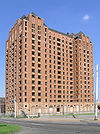 |
| Metropolitan Building Metropolitan Building (Detroit) The Metropolitan Building is a high-rise office building located on a triangular lot at 33 John R Street in downtown Detroit, Michigan, near Grand Circus Park.The building was built in 1924 and finished in 1925... |
1925 | Weston and Ellington Weston and Ellington Weston and Ellington Prolific Detroit based architectural firm operating in the 1910s and 1920s. They designed numerous apartment buildings, offices, auto sales buildings and other commercial structures, mostly in and around the city of Detroit.... |
33 John R. St. | Former jewelers building. Redevelopment plans include residential lofts. | 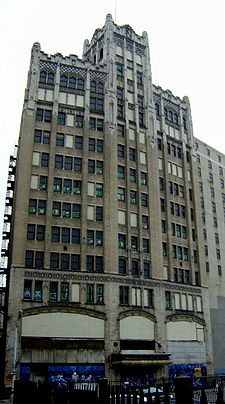 |
| Michigan Central Station Michigan Central Station Michigan Central Station , built in mid-1912 through 1913 for the Michigan Central Railroad, was Detroit, Michigan's passenger rail depot from its opening in 1913 after the previous Michigan Central Station burned, until the cessation of Amtrak service on January 6, 1988... |
1913 | Warren & Wetmore | 2405 W. Vernon Dr. | Owner filed plans in 2011 to add new windows and a roof. Listed on the National Register of Historic Places. Located near the Ambassador Bridge Ambassador Bridge The Ambassador Bridge is a suspension bridge that connects Detroit, Michigan, in the United States, with Windsor, Ontario, in Canada. It is the busiest international border crossing in North America in terms of trade volume: more than 25 percent of all merchandise trade between the United States... and the West Vernor-Junction Historic District West Vernor-Junction Historic District West Vernor-Junction Historic District is a commercial historic district located along West Vernor Highway between Lansing and Calvary in Detroit, Michigan. The district includes and 44 buildings. Parks near the neighorhood include Patton Park and Clark Park, named for U.S. Generals George S.... . |
|
| National Theatre Monroe Avenue Commercial Buildings The Monroe Avenue Commercial Buildings, also known as the Monroe Block, is a historic district located along a block-and-a-half stretch at 16-118 Monroe Avenue in Detroit, Michigan, just off Woodward Avenue at the northern end of Campus Martius. The district was designated a Michigan State Historic... |
1911 | Albert Kahn/ Ernest Wilby | 118 Monroe St. | Surviving historic structure on the Monroe block has Baroque-Beaux Arts-Moorish style. Construction of the nearby Cadillac Centre Cadillac Centre Cadillac Centre is a proposed contemporary complex to be constructed in downtown Detroit, Michigan on the Monroe block of Campus Martius. In January 2008, the city announced that the complex was approved for construction with groundbreaking planned for September 2009, but the project was placed on... residential complex increases prospects for redevelopment of the 2,200 seat National Theatre. |
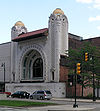 |
| 2643 Park Avenue | 1924 | Louis Kamper | 2643 Park Avenue | One of three hotels for Lew Tuller | 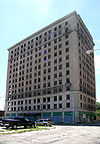 |
| Roosevelt warehouse Roosevelt Warehouse The Roosevelt Warehouse is an vacant building in Detroit on 14th & Marantette street. It is understood to have been designed by Albert Kahn and that it was originally a Post Office before being used as the Public School's Book Depository... |
14th Street | Former Detroit Public School's Book Depository | |||
| United Artists Theatre Building United Artists Theatre Building The United Artists Theatre Building is a vacant high-rise tower in downtown Detroit, Michigan, standing at 150 Bagley Street. It was constructed in 1928 and stands 18 stories tall. The building was designed by architect C. Howard Crane in the renaissance revival architectural style, and is made... |
1928 | C. Howard Crane | 150 Bagley St. | Possibility for redevelopment by Ilitch Holdings Ilitch Holdings Ilitch Holdings, Inc. was established in 1999 to provide all companies owned by Mike and Marian Ilitch with professional and technical services... . Theatre seating capacity is 2,070. |
 |
| Vanity Ballroom | 1926 | Charles N. Agree | 1024 Newport St. | Has served as a rock concert venue. |  |
| Wurlitzer Building | 1926 | Unknown. | 1509 Broadway St. | High-rise building in downtown which stands at 14 floors. The building is currently unused, but at one time held offices. Those offices originally served the Wurlitzer Organ Co., designed in the renaissance revival architectural style. It stands right next to the Metropolitan Building (Detroit) Metropolitan Building (Detroit) The Metropolitan Building is a high-rise office building located on a triangular lot at 33 John R Street in downtown Detroit, Michigan, near Grand Circus Park.The building was built in 1924 and finished in 1925... . |
|
See also
- Adaptive reuseAdaptive reuseAdaptive reuse refers to the process of reusing an old site or building for a purpose other than which it was built or designed for. Along with brownfield reclamation, adaptive reuse is seen by many as a key factor in land conservation and the reduction of urban sprawl...
- Building restorationBuilding restorationBuilding restoration describes a particular treatment approach and philosophy within the field of architectural conservation. According the U.S...
- Historic preservationHistoric preservationHistoric preservation is an endeavor that seeks to preserve, conserve and protect buildings, objects, landscapes or other artifacts of historical significance...

